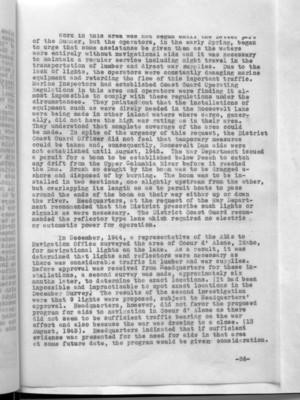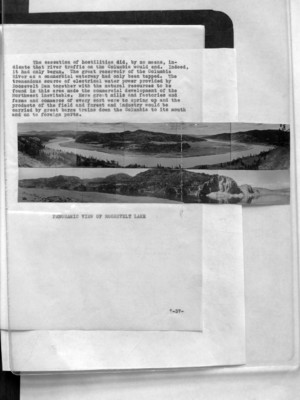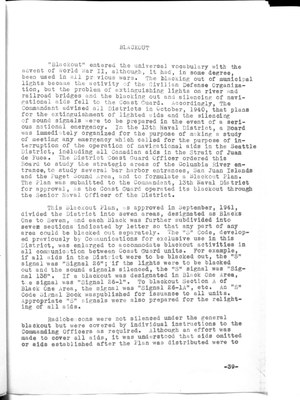Pages
56
Work in this area was not begun until the later part of the Summer, but the operators, in the early Spring, began to urge that some assistance be given them as the waters were entirely without navigational aids and it was necessary to maintain a regular service including night travel in the transportation of lumber and direct war supplies. Due to the lack of lights, the operators were constantly damaging marine equipment and retarding the flow of this important traffic. Marine Inspectors had established Coast Guard Operating Regulations in this area and operators were finding it almost impossible to comply with these regulations under the circumstances. They pointed out that the installations of equipment such as were direly needed in the Roosevelt Lake were being made in other inland waters where cargo, generally, did not have the high war rating as in their area. They understood that complete coverage of the area could be made. In spite of the urgency of this request, the District Coast Guard Officer did not feel that temporary measures could be taken and, consequently, Roosevelt Dam aids were not established until August, 1945. The War Department issued a permit for a boom to be established below Peach to catch any drift from the Upper Columbia River before it reached the Dam. Brush so caught by the boom was to be dragged ashore and disposed of by burning. The boom was to be installed in two sections, one slightly upstream from the other, but overlapping its length so as to permit boats to pass around the ends of the boom on their way either up or down the river. Headquarters, at the request of the War Department recommended that the District prescribe such lights or signals as were necessary. The District Coast Guard recommended the reflector type lens which required no electric or automatic power for operation.
In December, 1944, a representative of the Aids to Navigation Office surveyed the area of Coeur d' Alene, Idaho, for navigational lights on the lake. As a result, it was determined that lights and reflectors were necessary as there was considerable traffic in lumber and war supplies. Before approval was received from Headquarters for these installations, a second survey was made, approximately six months later, to determine the exact locations. (It had been impossible and impracticable to spot exact locations in the December Survey.) The results of the second investigation were that 9 lights were proposed, subject to Headquarters' approval. Headquarters, however, did not favor the proposed program for aids to navigation in Coeur d' Alene as there did not seem to be sufficient traffic bearing on the war effort and also because the war was drawing to a close. (13 August, 1945). Headquarters indicated that if sufficient evidence was presented for the need for aids in that area at some future date, the program would be given consideration.
-36-
57
The cessation of hostilities did, by no means, indicate that river traffic on the Columbia would end. Indeed, it had only begun. The great reservoir of the Columbia River as a commercial waterway had only been tapped. The tremendous source of electrical water power provided by Roosevelt Dam together with the natural resources to be found in this area made the commercial development of the Northwest inevitable. Here great mills and factories and farms and commerce of every sort were to spring up and the products of the field and forest and industry would be carried by great barge trains down the Columbia to its mouth and on to foreign ports.
(image) PANORAMIC VIEW OF ROOSEVELT LAKE
-37-
58
Abbreviated Statement of Tonnages Through Bonneville and Dalles-Celilo Canal (1911-1939) Through Bonneville Locks Through Dalles( Cascade Locks Prior to 1938) Celilo Canal
Period Oil Prod. Wheat Raft Logs Total Tonnage Oil Prod. Wheat Total Tonnage 1920 (Yearly Average) * 33807 (Canal Comp. 1915) 4020 1924 1926 1928 1930 1932 1934 1936 1938 1939
*Indicates that the tonnage, if any, was small and unimportant.
Note: Total petroleum products shown above are about 90% gasoline and 10% fuel and diesel oil.
59
"Blackout" entered the universal vocabulary with the advent of World War II, although, it had, in some degree, been used in all previous wars. The blacking out of municipal lights became the activity of the Civilian Defense Organization, but the problem of extinguishing lights on river and railroad bridges and the blacking out and silencing of navigational aids fell to the Coast Guard. Accordingly, The Commandant advised all Districts in October, 1940, that plans for the extinguishment of lighted aids and the silencing of sound signals were to be prepared in the event of a serious national emergency. In the 13th Naval District, a Board was immediately organized for the purpose of making a study of meeting any emergency which called for the purpose of interruption of the operation of navigational aids in the Seattle District, including all Canadian aids in the Strait of Juan de Fuca. The District Coast Guard Officer ordered this Board to study the Strategic areas of the Columbia River entrance, to study several bar harbor entrances, San Juan Islands and the Puget Sound Area, and to formulate a Blackout Plan. The Plan was submitted to the Commandant, 13th Naval District for approval, as the Coast Guard operated its blackout through the Senior Naval Officer of the District.
This Blackout Plan, as approved in September, 1941, divided the District into seven areas, designated as Blacks One to Seven, and each Black was further subdivided into seven sections indicated by letter so that any part of any area could be blacked out separately. The "S" Code, developed previously by Communications for exclusive use in this District, was enlarged to accommodate blackout activities in all communication between Coast Guard units. For example, if all aids in the District were to be blacked out, the "S" signal was "Signal 26"; if the lights were to be blacked out and the sound signals silenced, the "S" signal was "Signal 138". If a blackout was designated in Black One Area, the signal was "Signal 26-1A", etc. An "S" Code Signal Book was published for issuance to all units. Appropriate "S" signals were also prepared for the relighting of all aids.
Radiobeacons were not silenced under the general blackout but were covered by individual instructions to the Commanding Officers as required. Although an effort was made to cover all aids, it was understood that aids omitted or aids established after the Plan was distributed were to
-39-




